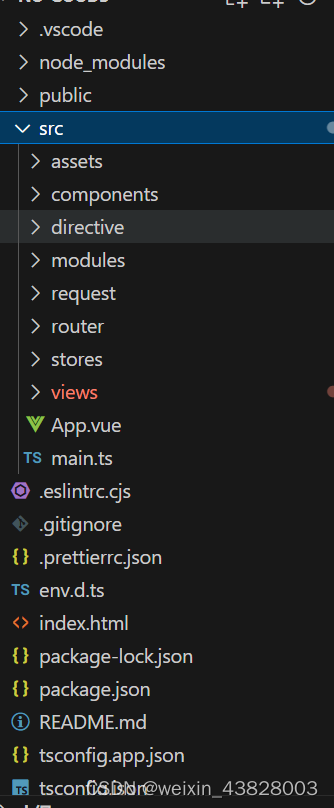项目结构介绍

| 模块名 | 说明 |
| views | 页面 |
| stores | pinia全局状态管理 |
| router | 路由 |
| request | axios请求封装 |
| modules | 模块数据格式封装 |
| directive | 自定义指令 |
| components | 组件 |
请求封装
request工具类封装
//导入axios
import axios from "axios";
import type{ AxiosInstance, AxiosResponse, InternalAxiosRequestConfig, AxiosRequestConfig,AxiosError } from "axios"
//element-plus 弹窗
import { ElMessage } from 'element-plus'
//响应结果类型
import type{result} from '@/modules/base/Base.ts'
//导入路由对象
import router from '@/router/index'
//导入token状态管理
import {useUserInfoStore} from '@/stores/UserInfo'
//根路径
export const config={
baseURL: 'http://localhost:9001',
timeout: 10000,
headers:{
'Content-Type':'application/json'
}
}
//请求类
export class HttpBase{
// axios的实例
private instance: AxiosInstance;
// 初始化的作用
constructor(configs: AxiosRequestConfig) {
// 创建axios的实例
this.instance = axios.create(configs)
// 配置拦截器
this.interceptors()
}
private interceptors() {
// 拦截请求
this.instance.interceptors.request.use((config: InternalAxiosRequestConfig) => {
//获取token
const token=useUserInfoStore().getToken
if(token){
config.headers.token=token
}
return config
}), (error: any) => {
error.data = {}
error.data.message = '服务器异常请联系管理员'
return error
}
// 拦截响应
this.instance.interceptors.response.use((res: AxiosResponse) => {
//获取token
const token=res.headers.token;
if(token){
useUserInfoStore().setToken(token)
}
// 这里面可以做一些接口返回状态的判断
//执行成功返回状态码以2开头,主要作用对于修改成功、新增成功等操作的消息提醒
if ( /^2/.test(res.data.code)) {
if(res.data.code!=200){
ElMessage.success(res.data.message)
}
return Promise.resolve(res.data)
} else {
//执行异常的消息提醒
ElMessage.error(res.data.message)
return Promise.reject(res.data.message || '接口报错')
}
},(error: AxiosError) => {
if(error.code==="ERR_NETWORK"){
ElMessage.error('请检查您的网络')
}else{
const status=error.response.status;
HttpBase.errorHandle(status)
}
return Promise.reject(error)
})
}
// 下面是对几个请求方式的封装
// post
protected post<T = result>(url: string, data?: object): Promise<T> {
return this.instance.post(url, data)
}
//put
protected put<T = result>(url: string, data?: object): Promise<T> {
return this.instance.put(url, data)
}
// get
protected get<T = result>(url: string, params?: object): Promise<T> {
return this.instance.get(url, { params })
}
// delete
protected delete<T = result>(url: string): Promise<T> {
return this.instance.delete(url)
}
// 图片上传
protected upload<T = result>(url: string, params?: object): Promise<T> {
return this.instance.post(url, params, {
headers: {
'Content-Type': 'multipart/form-data'
}
})
}
private static errorHandle(status:number) {
// 状态码判断
switch (status) {
case 404:
router.push('/404')
break
case 500:
router.push('/500')
break
default:
}
}
}菜单请求封装
import {HttpBase,config} from '@/request/base/index'
import type{ListMenu} from '@/modules/menu/MenuInfo'
// axios的配置项
const BaseUrl=config.baseURL+'/auth/menu'
class HttpMenu extends HttpBase{
/**
* 获取用户可访问权限
* @returns
*/
async getMenuByUser():Promise<Array<ListMenu>>{
//获取用户可访问菜单
const url=BaseUrl+'/getMenuByUserId'
return (await super.get(url)).data
}
}
export default new HttpMenu(config);数据实体封装
import type{BaseModule} from '@/modules/base/Base'
interface ListMenu extends BaseModule{
menuName:string,//菜单名称
menuCode:string,//菜单编码
parentId:number,//菜单父id
routerPath:string,//路由地址
componentPath:string,//组件所在位置
menuType:number,//菜单类型
authorityCode:string,//权限编码
requestUrl:string,//请求路径
children:Array<ListMenu>//子级
icon:string//菜单图标
}
export type{ListMenu} pinia全局状态管理封装
import { defineStore } from 'pinia'
import {computed, reactive, ref} from 'vue'
import type{ListMenu} from '@/modules/menu/MenuInfo'
import HttpMenu from '@/request/menu/Menu';
export const useMenuInfoStore = defineStore('menuInfo', () => {
//获取标识符
const menuFlag=ref<Boolean>(false)
//获取菜单是否获取标识符
const getMenuFlag=computed(()=>menuFlag.value)
//响应式菜单集合数据
const menuListInfo=reactive<Array<ListMenu>>([]);
//获取菜单权限
const getMenu=computed(async ()=>{
//判断是否有权限
if(!menuFlag.value){
await getMenuByUser();
}
menuFlag.value=true;
return menuListInfo;
})
//发送请求获取用户可访问菜单权限
async function getMenuByUser(){
try{
const result=await HttpMenu.getMenuByUser()
menuListInfo.push(...result)
}catch(e){
console.log(e)
}
}
return {getMenu,getMenuFlag}
})路由封装
import { createRouter, createWebHistory } from 'vue-router'
//登录页
import LoginView from '@/views/login/LoginView.vue'
//首页
import IndexView from '@/views/index/IndexView.vue'
//导入token 状态管理
import {useUserInfoStore} from '@/stores/UserInfo'
//导入获取权限状态管理
import { useMenuInfoStore } from '@/stores/MenuInfo'
const router = createRouter({
history: createWebHistory(import.meta.env.BASE_URL),
routes: [
{
path:'/',
redirect:'/login'
},
{
path:'/login',
name:'login',
component: LoginView
},
{
path:'/index',
name:'index',
component: IndexView
}
]
})
router.beforeEach( async (to,from,next)=>{
const userStore=useUserInfoStore();
const menuStore=useMenuInfoStore();
//验证是否登录
if(to.path!='/login'){
//获取token
const token=userStore.getToken
if(!token){
router.push('/login')
return ;
}
const menuFlag=menuStore.getMenuFlag;
//判断是否为首页并且没有获取过菜单权限
if(!menuFlag ){
const modules = import.meta.glob("@/views/*/*.vue");
//获取菜单权限
const menuList= await menuStore.getMenu
//循环遍历菜单
for(const menuInfo of menuList){
const children=menuInfo.children
if(children){
for(const childrenInfo of children){
const menu={
path:childrenInfo.routerPath,
name:childrenInfo.menuCode,
// component :() => import(`..${childrenInfo.componentPath}.vue`)
component :modules[`/src${childrenInfo.componentPath}.vue`]
}
router.addRoute('index',menu)
}
}
}
next({...to,replace:true})
return
}
}
next()
})
export default router
菜单渲染
<template>
<el-row class="tac">
<el-col >
<el-menu class="el-menu-vertical-demo" :router="true">
<el-menu-item index="/index">
<el-icon><House /></el-icon>
<span>首页</span>
</el-menu-item>
<el-sub-menu v-for="menu in menuList" :key="menu.id" :index="menu.id">
<template #title>
<el-icon><component :is="menu.icon"></component></el-icon>
<span>{{ menu.menuName }}</span>
</template><el-menu-item-group>
<template v-for="children in menu.children" :key="children.id">
<el-menu-item :index="children.id" :route="children.routerPath">
{{ children.menuName }}
</el-menu-item>
</template>
</el-menu-item-group>
</el-sub-menu>
</el-menu>
</el-col>
</el-row>
</template>
<script lang="ts" setup>
import { useMenuInfoStore } from '@/stores/MenuInfo'
import { reactive } from 'vue'
import type { ListMenu } from '@/modules/menu/MenuInfo'
import { onMounted } from 'vue'
//菜单集合
let menuList = reactive<Array<ListMenu>>([])
//菜单全局管理对象
const menuStore=useMenuInfoStore();
//获取菜单集合
const getMenu = async () => {
const menuInfoList = await menuStore.getMenu
menuList.push(...menuInfoList)
}
onMounted(() => {
getMenu()
})
</script>
<style scoped>
.el-row {
height: 100%;
}
.el-menu {
height: 100%;
}
</style>






 本文介绍了在一个Vue应用中,如何使用Pinia进行全局状态管理,以及如何通过axios进行API请求的封装,包括基础请求方法、错误处理和菜单权限获取。同时展示了路由守卫和菜单渲染的实现细节。
本文介绍了在一个Vue应用中,如何使用Pinia进行全局状态管理,以及如何通过axios进行API请求的封装,包括基础请求方法、错误处理和菜单权限获取。同时展示了路由守卫和菜单渲染的实现细节。
















 197
197

 被折叠的 条评论
为什么被折叠?
被折叠的 条评论
为什么被折叠?










